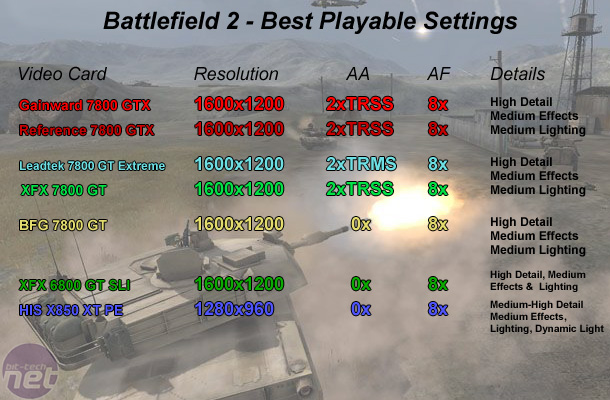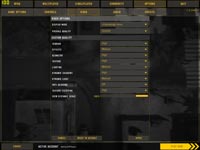Leadtek 7800 GT and ForceWare 78.03
September 29, 2005 | 17:40

How We Tested:
Please be aware that the way we test our video cards is not a like-for-like comparison, and it is not meant to be. We decided to concentrate on finding the "Best Playable" settings - this means that we're finding the best possible gaming experience delivered on each different configuration. There are no time demos used in our evaluations - we're focusing on the real-world gaming experience, which is, ultimately what should determine your next graphics card's purchase.Rather than focusing on reporting the minimum and average frame rates for every configuration, we have decided to move the focus to resolution and settings. Thus, we are displaying our "Best Playable" resolutions and settings in a table that should be easier to understand than our previous format. If you take the logic that the higher the resolution and in game details, the faster the video card, you will not go far wrong.
In situations where we find that two competing video cards run at the same settings, we will bring the frame rates in to the discussion of our game play experiences with each particular video card.
System Setup
AMD Athlon 64 FX-57 (operating at 2800MHz - 14x200); DFI LANPARTY nF4 SLI-DR (NVIDIA NForce4 SLI); 2 x 512MB OCZ PC5000 Platinum Series (operating in dual channel with 2.0-2-2-10 timings); Western Digital 200GB Caviar SATA 150 Hard disk drive; OCZ PowerStream 520W Power Supply; Windows XP Professional Service Pack 2; DirectX 9.0c; NVIDIA NForce4 Standalone chipset drivers, version 6.53.Video Cards:
- 1 x Leadtek PX7800 GT TDH MyVIVO Extreme - operating at its default clock speeds of 450/1050MHz using Forceware version 78.03 available from NZone.
- 1 x BFGTech GeForce 7800 GT OC - operating at its default clock speeds of 425/1050MHz using Forceware version 77.77 WHQL.
- 1 x XFX GeForce 7800 GT - operating at its default clocks speeds of 450/1050MHz using Forceware version 77.77 WHQL.
- 1 x Gainward PowerPack! Ultra/3500PCX Golden Sample - GeForce 7800 GTX 256MB - operating at its default clock speeds of 470/1300MHz using Forceware 77.76, available on NZone.
- 1 x NVIDIA Reference GeForce 7800 GTX 256MB - operating at its default clock speeds of 430/1200MHz using Forceware 77.76.
- 1 x HIS Radeon X850 XT PE 256MB - operating at its default clock speeds of 540/1180MHz using Catalyst 5.7 WHQL with Catalyst Control Center.
- 2 x XFX GeForce 6800 GT - operating at clock speeds of 350/1000MHz in SLI mode using Forceware version 77.76.
______________________________
Battlefield 2
Publisher: Electronic ArtsWe used the follow up to Battlefield 1942 and Battlefield: Vietnam, Battlefield 2. It features an all-new game engine based on the DirectX 9.0 API. There is no Shader Model 3.0 support, but the majority of hardware will use a Shader Model 2.0++ mode that includes support for Normal Maps, Parallax Mapping, Full-Resolution Dynamic Shadowing, Post Processing and Fog.
The game will look the same on both NVIDIA and ATI hardware, so there is no advantage of choosing one over the other in image quality related circumstances. The only major difference is that Ultra Shadow 2 is utilised on NVIDIA's hardware, while the Shadowing on ATI hardware is done using a slightly different technique.
We played five five-minute segments of the same map, reporting the median frame rate. We found that there was no ready way to duplicate testing situations manually in this game, so we felt that taking a typical slice of action from the game was the best way to report our findings. We controlled Anti-Aliasing from inside the game, while Anisotropic Filtering was set to 8xAF when the 'Texture Filtering' option was set to 'High'.
Below is a table of the best-playable settings that we found best for each video card configuration. In this title, we found that 25 to 30 frames per second minimum and a target of 60 frames per second (or higher) for the average frame rate delivered a smooth and fluid gaming experience.

With the ForceWare 78.03 driver and 2x SuperSampled Transparency AA, we experienced minimum frame rates below 25 frames per second on several occasions. This happened when we were engaged in a heavy firefight with lots of explosions and it meant that the game was not quite as smooth as we desired. However, dropping the settings to 1600x1200 2xTRMS AA 8xAF with most in-game details set to high meant that we experienced smooth game play at a 73 frames per second average with a minimum frame rate of 27 frames per second.

MSI MPG Velox 100R Chassis Review
October 14 2021 | 15:04






Want to comment? Please log in.